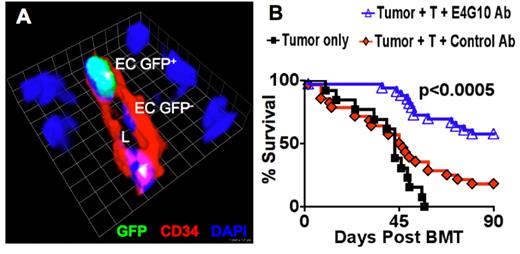Abstract
Neo-vascularization has been implicated in a number of inflammatory diseases as well as tumor growth. Both angiogenesis, the sprouting of resident tissue endothelial cells (ECs), and vasculogenesis, the recruitment of bone marrow (BM)-derived circulating endothelial progenitor cells (EPCs), are thought to participate in neo-vascularization. EPCs have been implicated in tumor growth, however, the biologic significance of EPCs during inflammation is unclear.
We studied neo-vascularization and the role of EPCs during inflammation in well-characterized murine models of graft-versus-host disease (GVHD). We found a significantly increased number of donor BM-derived EPCs in peripheral blood and BM in allogeneic bone marrow transplantation (allo-BMT) recipients with GVHD at different time points after BMT. We next quantified neo-vascularization during inflammation in GVHD target organs by immunofluorescence microscopy and by flow cytometry. We found significantly increased numbers of donor-derived ECs in the liver as well as a significantly higher vessel density in the liver, illeum and colon. We adoptively transferred selected GFP+ EPCs and observed incorporation into the neo-vasculature of the inflamed intestines (Fig. 1A) and liver during GVHD. Taken together, these data suggest that neovascularization during GVHD is due to vasculogenesis from donor EPCs.
Next we used an antibody (E4G10) against the vascular endothelial adhesion molecule VE-cadherin, which recognizes a terminal epitope that is exposed on circulating EPCs, but is masked in the established vasculature, and found a significant reduction of EPCs in the peripheral blood and BM. We observed that depletion of EPCs was associated with a significant inhibition of donor BM-derived neo-vascularization in the liver, illeum and colon during GVHD. E4G10 treated recipients had significantly better survival and lower clinical GVHD scores in all tested models (B6BALB/c [1×106 T], B6B6D2F1 [1×106 T], B6B6D2F1 [2×106 T], B6B6D2F1 [3×106 T]). We found significantly reduced numbers of allo-reactive donor T cells in secondary lymphoid organs during GVHD, but no changes in the expression of activation markers and homing molecules, as a consequence of E4G10 administration. In blinded histopathological analyses we found significantly less GVHD and reduced numbers of tissue-infiltrating CD3+ T cells in the liver, illeum and colon in E4G10-treated allo-BMT recipients.
To better emulate the clinical setting, we first assessed the role of EPCs in tumor growth in allo-BMT recipients. We transferred sorted GFP+ EPCs as well as renal carcinoma (RENCA) cells to BALB/c recipients and found that GFP+ EPCs were recruited to the neo-vasculature of lung metastases. We detected a significant inhibitory effect of E4G10 administration on tumor growth, as determined by in vivo bioluminescence imaging, in both tumors tested (RENCA, A20 lymphoma) as well as a significant survival prolongation in tumor-bearing mice that were treated with E4G10 in the RENCA and C1498 (AML) model.
Finally, we performed experiments in which tumor-bearing allo-BMT recipients received allogeneic T cells, which mediate the favorable graft-versus-tumor (GVT) effect but also cause inflammation in GVHD target organs. We found that administration of E4G10 led to a significantly higher rate of tumor-free survival in all models (B6'BALB/c [1×105 B6 T and 2×105 RENCA], B10BR'B6 [1×105 B10BR T and 2×105 C1498], B6'BALB/c [2×105 B6 T and 5×105 A20]), which was due to both attenuation of GVHD as well as inhibition of tumor growth (Fig. 1B).
We conclude that depletion of EPCs is a strategy to simultaneously ameliorate inflammatory disease and tumors, providing a new approach to improve therapeutic outcome of allogeneic hematopoietic stem cell transplantation. This study demonstrates the biological significance of EPCs for neo-vascularization during inflammation and identifies the specific targeting of EPCs to disrupt neo-vascularization as a novel therapeutic concept to decrease inflammation.
(A) EPCs are incorporated in neo-vasculature during GVHD. Sorted B6 GFP+EPCs (20,000), B6 GFP-BM and GFP-T cells were transferred at the day of BMT. GFP+EPC derived GFP+ECs are surrounding the luminal (L) space in neo-vasculature of the inflamed colon at day +14 after allo-BMT. (B) Depletion of EPCs leads to improved survival of tumor bearing allo-BMT recipients with GVHD due to simultaneous beneficial effects on inflammation and tumor growth. Lethally irradiated recipients were transplanted with 5×106 donor BM cells, 2.5×105 donor T cells, challenged intravenously with A20 lymphoma at day 0 and treated with 1 mg E4G10 or control antibody i.p. at days 0,2,4,6,8 and 10 after allo-BMT, combined data of 3 experiments are showm, n=28–33 per group.
(A) EPCs are incorporated in neo-vasculature during GVHD. Sorted B6 GFP+EPCs (20,000), B6 GFP-BM and GFP-T cells were transferred at the day of BMT. GFP+EPC derived GFP+ECs are surrounding the luminal (L) space in neo-vasculature of the inflamed colon at day +14 after allo-BMT. (B) Depletion of EPCs leads to improved survival of tumor bearing allo-BMT recipients with GVHD due to simultaneous beneficial effects on inflammation and tumor growth. Lethally irradiated recipients were transplanted with 5×106 donor BM cells, 2.5×105 donor T cells, challenged intravenously with A20 lymphoma at day 0 and treated with 1 mg E4G10 or control antibody i.p. at days 0,2,4,6,8 and 10 after allo-BMT, combined data of 3 experiments are showm, n=28–33 per group.
Disclosures: May: ImClone Systems Incorporated: Employment.
Author notes
Corresponding author


This feature is available to Subscribers Only
Sign In or Create an Account Close Modal